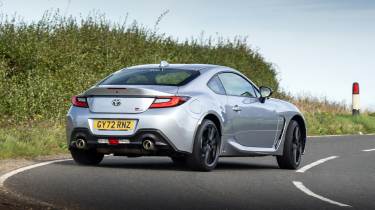Toyota GT86 v GR86: how Toyota perfected the affordable sports car
The GT86 bucked all the usual sports car trends in 2012, then the GR86 honed that recipe to perfection
It doesn't feel all that long ago Toyota was the blandest of bland, the beigest of beige car brands. When evo issue 001 was published, Carlos Sainz’s Corolla was vying with Tommi Mäkinen’s Mitsubishi Lancer for the WRC title, a brace of Toyota GT‐Ones had taken on the Le Mans 24 Hours, and the Celica and MR2 were mainstays in the company’s line-up. But in the years to come, performance cars disappeared from Toyota brochures while, elsewhere in the range, cars like the RAV4 morphed from inventive lifestyle vehicle to anonymous SUV dross. Despite a (slightly baffling) eight-season F1 campaign from ’02 to ’09, Toyota was a resolutely unsporting brand. One of the biggest car companies in the world, an industry powerhouse, but for enthusiasts – nothing to see here.
So it was perhaps a surprise when the GT86, created in partnership with Subaru, sprang onto the stage in 2012. Together with its Subaru BRZ counterpart, it was a car that pushed against the tide: less power, less weight, less grip – the antithesis of the automotive arms race. Even if it wasn’t embraced quite as wholeheartedly as Toyota/Subaru might have hoped in terms of sales or praise (evo was guarded in its reviews, applauding the car’s ethos more than its execution), it’s gone on to become a cult hero.
Rightly so. Driving one today, everything that’s so fundamentally right about it comes flooding back: the just-so-ness to the driving position, the pedal set-up, the control weights, the suspension with just the right amount of give for British roads, the dimensions that are just the right size. All of the shortcomings, too: the low-rent, tacky interior (with the ubiquitous red digital clock Toyota must have bought a serious job-lot of in the 2010s), the gearchange that’s notchy and knobbly from cold, and the 2-litre boxer’s dearth of low-down torque.
More reviews
Group tests
- Alpine A290 v Alpine A110 – how much DNA do they really share?
- Ariel Atom 4R v Caterham Seven ‘evo25’: power-to-weight heroes go head-to-head
- Caterham Super Seven 600 v Super Seven 2000
- Levante v T1
- Corvette Stingray v Porsche Cayman GTS v Audi R8 RWD
- Great Ferrari hypercars driven: 288 GTO, F40, F50 and Enzo head-to-head
- Hardcore Ferrari V8 specials go head-to-head
- Lamborghini Aventador Ultimae v Lamborghini Countach
- Lotus Emira v Morgan Plus Four – four-cylinder Brits go head-to-head
- Toyota GR86 v BBR Mazda MX-5: supercharged drop-top battles sports coupe
In-depth reviews
- Abarth 600e 2025 review – Italy gives the Alpine A290 something to worry about
- Alpine A110 review – distinctive, lightweight and unforgettable to drive
- Audi R8 (2015 - 2024) review – the ultimate soft-focus supercar
- Bentley Continental R Mulliner: review, history and specs
- BMW 5-series review – is this still Munich’s anchor model?
- BMW 1-series review – Munich’s Audi A3 rival gains focus
Long term tests
- Abarth 695C Turismo Fast Fleet test – 10,000 miles in the Italian hot hatch
- Alfa Romeo Giulia Veloce Fast Fleet test – 7000 miles in the sharp Italian saloon
- Alpina B10: end of term report
- Alpina B10
- Ford Mustang GT
- Ford Mustang GT
- Ford Mustang GT
- Land Rover Defender 110 Fast Fleet test – 9000 miles in the go-anywhere SUV
- Maserati Ghibli Trofeo Fast Fleet test – 4000 miles in the Ferrari-powered saloon
- Mitsubishi Evo MR 340
Review
- New Aston Martin DBS 770 Ultimate review – 759bhp super-GT driven
- New Bentley Batur 2023 review – can it possibly be worth £1.65m?
- 2023 Chevrolet Corvette C8 Z06 review – the American 911 GT3?
- Kia EV6 GT-Line S prototype review – the EV that shows how it’s done
- BBR Supercharged Mazda MX-5 (ND) 2023 review – tuned 250bhp roadster driven
- MG4 Trophy 2023 review
Reviews
- Abarth 695 75 Anniversario edition 2024 review – a fitting send-off for Abarth’s hot supermini?
- Abarth 500e 2023 review
- AC Cobra 378 Superblower MkIV 2021 review – another V8 Cobra, but with a GM heart this time
- Acura Integra Type S 2024 review – a Honda Civic Type R with added restraint
- Alfa Romeo Giulia 2025 review – get one while you still can
- Alfa Romeo SZ: history, review and specs of an icon
- Alfa Romeo 1750 TBi
- Alpina B3 GT Touring 2025 review – a 190mph alternative to the BMW M3 Touring
The skinny, low- rolling-resistance Michelin Primacy tyres are a double-edged sword, giving the GT86 up-on-its-toes handling at all speeds but a tendency to stumble into oversteer abruptly. With the stability control switched on, it cuts in so jarringly, nipping the brakes to straighten the car, that it’s more unnerving than the tyres letting go in the first place.
They’re subjective niggles rather than problems as such, but they limited the GT86’s appeal; 2022’s GR86 replacement fixed them all, and morphed the 86 into a more grown-up car, a more rounded proposition, without losing its sense of fun.
More than two-thirds of the car is all-new, and while the boxer uses the same block as the GT86, it’s bored out to 2.4 litres; yet it is no heavier, thanks to thinner cylinder liners, resin rocker covers and other measures. A chunk of extra peak torque arrives 3000rpm earlier, meaning steep hills no longer require a downshift or two, and rice pudding skins can no longer rest easy.
A significantly stiffer shell helps make the handling more precise, and measures such as liquid-filled engine mounts make the car more refined too: a long journey in a GT86 can leave you feeling drained but the GR86 is a much more useable car, yet equally exciting to drive at all speeds. More exciting, in fact; not for nothing did the GR86 outscore both Ferrari 296 GTB and McLaren Artura on eCoty 2022. Meanwhile the increase in weight over the GT86 is negligible and the same goes for the price (£32,495).
When you could still buy the GR86 from new, that is. The two batches of UK-bound cars have now been spoken for, and European safety protocols mean that a substantial redesign of the car’s shell would be required to sell it on our shores in the future.
Spurred on by Akio Toyoda, Toyota’s arch-enthusiast chairman, the Gazoo Racing division – the slightly odd name for which there isn’t a direct English translation – has supported the World Endurance Championship through lean times, continues to investigate hydrogen-fuelled engines as a future power source for road and race cars, has become a dominant force in the World Rally Championship (Toyoda is currently in talks with the FIA about finding a way to support a return of Subaru to the championship too) and spawned the brilliant GR Yaris road car in the process – and the equally brilliant GR86.
Perhaps the GR86’s greatest significance is that it is likely to be the world’s last brand-new affordable conventional sports car to be launched. It’s a cruel set of circumstances that means it’s not an attainable one. Because it’s a brilliant concept, and one which crystallises all that the GT86 set out to achieve.






